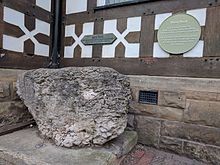
Gildas — also known as Gildas Badonicus, Gildas fab Caw and Gildas Sapiens — was a 6th-century British monk best known for his scathing religious polemic De Excidio et Conquestu Britanniae, which recounts the history of the Britons before and during the coming of the Saxons. He is one of the best-documented figures of the Christian church in the British Isles during the sub-Roman period, and was renowned for his Biblical knowledge and literary style. In his later life, he emigrated to Brittany, where he founded a monastery known as Saint-Gildas-de-Rhuys.

Ruthin is a market town and community in Denbighshire, Wales, in the south of the Vale of Clwyd. It is Denbighshire's county town. The town, castle and St Peter's Square lie on a hill, skirted by villages such as Pwllglas and Rhewl. The name comes from the Welsh rhudd (red) and din (fort), after the colour of sandstone bedrock, from which the castle was built in 1277–1284. The Old Mill, Ruthin, is nearby. Maen Huail, a registered ancient monument attributed to the brother of Gildas and King Arthur, stands in St Peter's Square.

Denbighshire is a county in the north-east of Wales. It borders the Irish Sea to the north, Flintshire to the east, Wrexham to the southeast, Powys to the south, and Gwynedd and Conwy to the west. Rhyl is the largest town, and Ruthin is the administrative centre. Its borders differ from the historic county of the same name.

Until 1974, Denbighshire, or the County of Denbigh, was an administrative county in the north of Wales, later classed as one of the thirteen historic counties of Wales. It was a maritime county, that was bounded to the north by the Irish Sea, to the east by Flintshire, Cheshire and Shropshire, to the south by Montgomeryshire and Merionethshire, and to the west by Caernarfonshire.
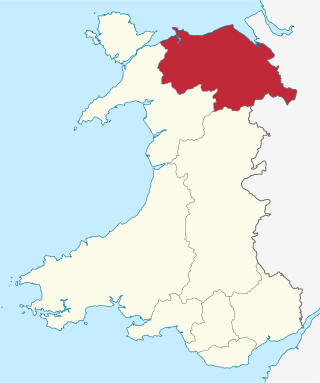
Clwyd is a preserved county of Wales, situated in the north-east corner of the country; it is named after the River Clwyd, which runs through the area. To the north lies the Irish Sea, with the English ceremonial counties of Cheshire to the east and Shropshire to the south-east. Powys and Gwynedd lie to the south and west respectively. Clwyd also shares a maritime boundary with Merseyside along the River Dee. Between 1974 and 1996, a slightly different area had a county council, with local government functions shared with six district councils. In 1996, Clwyd was abolished, and the new principal areas of Conwy County Borough, Denbighshire, Flintshire and Wrexham County Borough were created; under this reorganisation, "Clwyd" became a preserved county, with the name being retained for certain ceremonial functions.
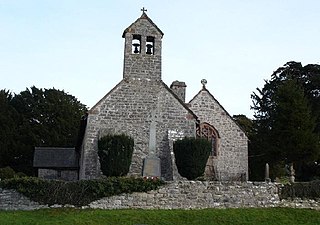
Llanelidan is a small village and community in the county of Denbighshire in north-east Wales. The community also includes the hamlet of Rhyd-y-Meudwy.

The Ruthin and Cerrig-y-Drudion Railway was a proposed 1 ft 11+1⁄2 in narrow gauge railway that would have linked the towns of Ruthin and Cerrig-y-Drudion in Denbighshire, Wales. A bill was put before Parliament in 1873, promoting the railway, which was intended to meet the planned branch of the North Wales Narrow Gauge Railways from Beddgelert at Cerrig-y-Drudion.

Moel y Gaer, also known as Moel-y-Gaer Camp or Moel y Gaer Hillfort, is an Iron Age hillfort located on a western spur of the Clwydian Range, near the village of Llanbedr, Denbighshire, Wales. The site is a scheduled monument, classified as a prehistoric defensive hillfort.
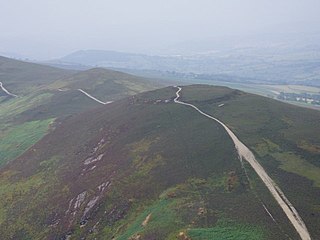
Moel y Gaer is an Iron Age hillfort on a summit of Llantysilio Mountain, northwest of the town of Llangollen, Denbighshire, Wales. The site is a scheduled monument classified as a prehistoric defensive hillfort.

Peers Memorial is in St Peter's Square, Ruthin, Denbighshire, Wales. It is designated by Cadw as a Grade II listed building.

The Collegiate and Parochial Church of St Peter is the Anglican parish church of Ruthin, an ancient market town which lies within the Vale of Clwyd in Denbighshire, north east Wales. It is a greater church of the diocese of St Asaph and a Grade I listed building.
In Welsh tradition, Hueil mab Caw was a Pictish warrior and traditional rival of King Arthur's. He was one of the numerous sons of Caw of Prydyn and brother to Saint Gildas.

Maen Llia is a standing stone which sits on moorland at grid reference SN924192 in the Brecon Beacons National Park in Powys, Wales.

Efenechtyd is a hamlet and community in a deep valley in Denbighshire, Wales which contains the Church of St Michael and All Angels. The community includes the village of Pwllglas. Efenechtyd is also the name of an electoral ward.

Cornish promontory forts, commonly known in Cornwall as cliff castles, are coastal equivalents of the hill forts and Cornish "rounds" found on Cornish hilltops and slopes. Similar coastal forts are found on the north–west European seaboard, in Normandy, Brittany and around the coastlines of the British Isles, especially in Wales, Scotland and Ireland. Many are known in southwest England, particularly in Cornwall and its neighbouring county, Devon. Two have been identified immediately west of Cornwall, in the Isles of Scilly.

Waen is a sparsely populated community in the Vale of Clwyd, in the Welsh county of Denbighshire. It includes the hamlet of Waen Goleugoed. The former civil parish was created in 1896 from the Flintshire portion of St Asaph, and lies on the eastern bank of the River Clwyd, 2.7 miles (4.3 km) east of St Asaph, 15.4 miles (24.8 km) north west of Mold, 5.1 miles (8.2 km) north of Denbigh and 11.9 miles (19.2 km) north of Ruthin. At the 2001 census the community had a population of 245, falling slightly to 241 at the 2011 census. The North Wales Expressway (A55) crosses the community from east to west, on its route from Chester to Bangor.

Ruthin Town Hall is a municipal facility in Market Street, Ruthin, Denbighshire, Wales. It is a Grade II listed building.
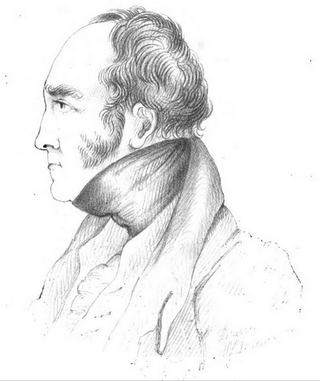
Joseph Ablett was a philanthropist and High Sheriff of Denbighshire, a county in Wales, in 1809.
Lloyd Williams and Underwood was a firm of architects based in Denbigh and active mostly in North Wales in the second half of the 19th century. The partners were Richard Lloyd Williams, formerly a pupil of Thomas Fulljames, and Martin Underwood, who was also county surveyor for Denbighshire. Several of their designed now have listed status.
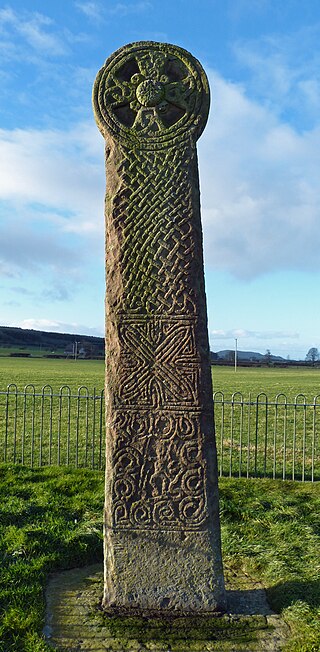
Maen Achwyfan or Maen Achwyfan Cross, located near the village of Whitford in Flintshire, Wales, is a high cross. Standing 3.4 metres (11 ft) high, it is the tallest wheel cross in Britain, and is a Scheduled monument.
